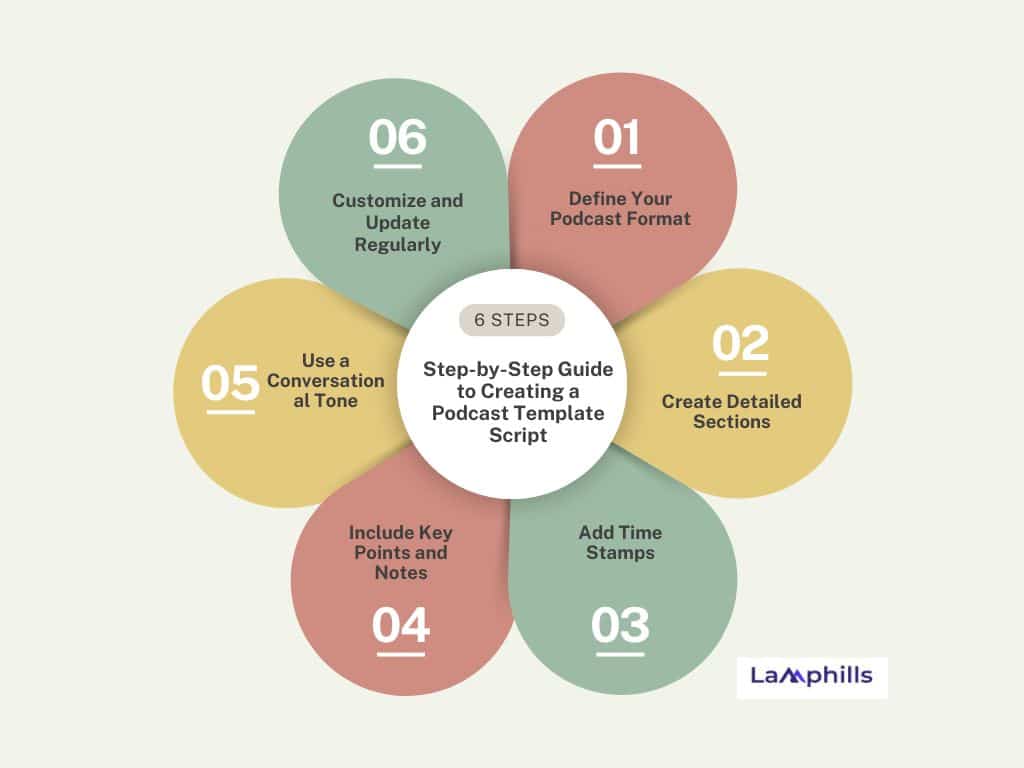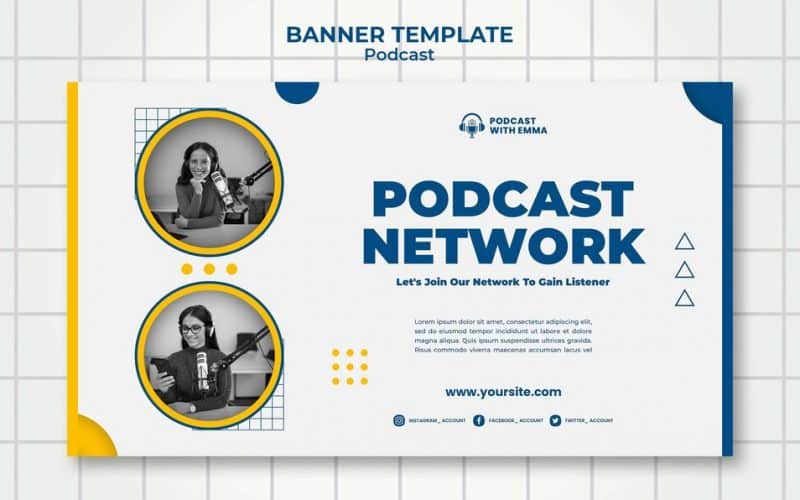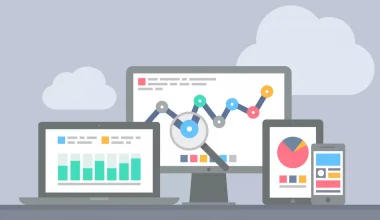If you’re reading this, you’re probably either thinking about starting your own podcast or looking to improve your existing one. Either way, you’ve come to the right place. Today, I will be diving into the podcast templates space. I’ll explore what a podcast template is, why you need one, and how to create the perfect podcast template script. Plus, I’ll share some free podcast template resources and tips on crafting a video podcast template. So, let’s get started, shall we?
Key Takeaways
- A podcast template is a pre-structured outline that guides the flow of your podcast episodes, making your podcasting process more efficient, consistent, and engaging. It helps you stay organized, cover all necessary points, and deliver professional content, ultimately enhancing listener experience and building a loyal audience.
- Creating a podcast template involves defining your podcast format, creating detailed sections for each part of the episode (intro, main content, outro), adding timestamps to stay on track, including key points and notes, using a conversational tone, and customizing and updating the template regularly based on feedback and experience.
- There are different types of podcast templates available. These cater to various formats (interview, solo, narrative) and content styles (minimalist, effects-heavy). Choose one that aligns with your vision and technical expertise.
- A video podcast template includes visual elements, camera cues, and editing notes to ensure engaging video content. It helps plan shots, prepare interview questions, and structure content for maximum visual impact, maintaining a consistent visual style and saving time during filming and editing.
What is a Podcast Template?
Let’s start with the basics. What is a podcast template? In simple terms, a podcast template is a pre-structured outline that guides the flow of your podcast episodes. It’s like having a roadmap that helps you stay on track, ensuring you cover all the important points without missing anything. A good template can make your podcasting process more efficient and your episodes more consistent and engaging.
I remember when I started my first podcast. I was so excited, but also a bit overwhelmed. Had a million ideas buzzing in my head, but no clear direction. My early episodes were all over the place and also a mess. Then, I discovered the power of a podcast template. It was a game-changer. Suddenly, I had a structure to follow, which made everything so much easier.
Why Do You Need a Podcast Template?
Using a podcast template offers numerous benefits, and the stats back it up. According to a survey by Podtrac, podcasters who use templates report a 30% increase in production efficiency. Furthermore, these podcasters are 25% more likely to publish episodes consistently compared to those who don’t use templates.
Consistency is key in podcasting. Listeners appreciate a familiar structure, and a template ensures you deliver a consistent experience every time. It helps build a loyal audience who knows what to expect from each episode.
Efficiency is another significant advantage. With a template, you cut down on preparation time. This was a game-changer for me. Instead of spending hours organizing my thoughts, I could jump straight into content creation. It also helped me avoid the dreaded podcaster’s block – that moment when you sit in front of a blank screen, unsure where to start.
Quality is maintained when you follow a structured approach. Your episodes are well-organized, transitions are smooth, and the content flows naturally. This level of professionalism can attract more listeners and potential sponsors.
Speaking from experience, I can tell you that my episodes improved significantly once I started using a template. My listeners noticed too. I received comments about how much more polished and professional my podcast sounded. It was incredibly rewarding to see that kind of feedback.
What Makes a Good Podcast Template?
A good podcast template allows you to keep to an agreed-upon podcast format while also providing you the freedom to be creative. After all, a podcast script is not the same as a play script, which requires you to memorize every word.
A great podcast script, like a good podcast introduction, ought to make room for ad-lib and improvisation.
More experienced podcast hosts can get by with bullet points, but beginners may wish to compose a more detailed podcast script, at least the first time around. This can help you avoid anxiousness and straying off on tangents.
A podcast script or outline also informs your guests of what to expect: when should they be ready to pitch in, and when should they leave room for a call to action (CTA)?
In addition to scripts, podcast templates can be used at any stage of your process to ensure a consistent, standardized approach to podcast creation. These podcast templates can keep you on track, from scheduling social media posts to preparing next week’s episode.
Podcast Template Script
A podcast template script is a pre-written framework that outlines the structure and key elements of your podcast episodes. It includes detailed sections for your intro, main content, transitions, and outro, guiding you through the recording process.
Step-by-Step Guide to Creating a Podcast Template Script
Check the infographics below for the step-by-step guide to creating a template script:

Let’s break it down further:
#1. Define Your Podcast Format
Start by outlining the basic structure of your podcast. Think about the format that works best for your content and audience. Here are some common elements to consider:
- Introduction: Welcome your listeners and introduce the episode’s topic.
- Segments: Break down the main content into manageable sections.
- Transitions: Smoothly move from one segment to another.
- Outro: Wrap up the episode, summarize key points, and include calls to action.
#2. Create Detailed Sections
Once you’ve defined your format, create detailed sections for each part of your podcast. Here’s a breakdown:
Introduction:
- Greeting: A friendly welcome to your listeners.
- Episode Overview: Briefly mention what the episode will cover.
- Personal Note: Share a personal anecdote or comment to connect with your audience.
Main Content:
- Segment 1: Detailed discussion of the first topic.
- Transition: A sentence or two to smoothly move to the next segment.
- Segment 2: Discussion of the second topic.
- Transition: Another smooth move to the next segment.
- Additional Segments: Repeat as needed.
Outro:
- Summary: Recap the main points of the episode.
- Call to Action: Encourage listeners to subscribe, leave reviews, or visit your website.
- Sign-Off: A friendly farewell.
#3. Add Time Stamps
Including timestamps in your script can help you stay on track and ensure each segment fits within your desired episode length. Estimate how long you’ll spend on each section and adjust as needed.
#4. Include Key Points and Notes
Within each segment, jot down key points and notes you want to cover. This will help you stay focused and ensure you don’t miss any important information.
#5. Use a Conversational Tone
Your script should be written in a conversational tone, as if you’re talking directly to your listeners. Avoid overly formal language and make it sound natural and engaging. I always imagine I’m chatting with a friend when recording. This helps me maintain a relaxed and conversational tone, which my listeners appreciate.
#6. Customize and Update Regularly
Your podcast template script should be a living document. Customize it to fit your unique style and update it regularly based on feedback and your own experiences. I regularly tweak my script based on listener feedback. For instance, when listeners asked for more detailed reviews, I added a section for in-depth analysis.
Check out this video below:
Free Podcast Template
Whether you’re starting a new productivity podcast or looking to improve your interview podcast, start with one of these free podcast templates:
#1. Lamphills Podcast Template
This helpful Lamphills Podcast Template allows you to easily keep track of all of your podcast scripts and episodes in one spot, sorting them by Series, Season, or other custom categories.
You can include publishing dates, episode links, audio, and other information so you don’t have to hunt through many pages to locate what you’re looking for. To navigate easily, simply switch between Board and List views.
Assign a host or producer to each podcast using the Assignee field, and provide the episode topic in the Topic field. You can also use status markers such as Edited, Planned, Posted, and Recorded to track where each episode is in the production process.
Although this is a beginner-friendly podcast template, it’s comprehensive enough to manage larger productions with multiple episodes and team members.
#2. ClickUp Podcast Sponsorship Template
This Podcast Sponsorship Template is intended to help you court sponsors by giving them a concise yet informative description of your podcast show.
Your sponsorship request for the proposal should include information about the target demographic, the scope of the opportunity (e.g., listener statistics), and campaign details. Include your contact information, as well as your logo or podcast cover art, to make your sponsorship proposal more professional-looking.
Reaching out to firms that share your podcast’s ideas can help you create revenue while also promoting brands that your listeners will be interested in. It’s a win-win for both your program and your new sponsor!
#3. Conversation/Interview Show Podcast Template
Riverside’s Conversation/Interview Show Podcast Template provides a useful structure for writing an interview-style show script. Riverside provides several podcast script examples, including a minimalist script and a solo program.
The conversation/interview template includes an introduction, sponsor message, and theme music, followed by a guest introduction and interview questions. The show concludes with an outro, recap, and call to action.
Several of the bullet points include a blank space for the duration, where you can record the length of each segment. This is simple if you have any pre-recorded segments, such as the theme music and sponsor message; otherwise, just estimate it and update the information once you’ve recorded the show.
#4. Nonfiction Storytelling Template by Ausha
Ausha’s Non-Fiction Storytelling Template is designed for single podcast producers who wish to tell their listeners a story throughout an episode. This could range from a true crime podcast to an in-depth look at a historical incident or scientific discovery.
The outline begins with the intro music and a roadmap or summary of the program. That is followed by three topic segments, a sponsor message, and a summary. Finally, there’s an outro with a call to action and a teaser for the next episode.
Instead of writing a word-for-word script, this template enables you to create bullet points providing vital information, allowing you to strike a more conversational tone. Don’t forget to write down segues from one topic to another to keep you on track!
#5. Solo Show
If you are the sole host of your podcast, you may find it helpful to have a well-thought-out script and outline for each episode. Because you’ll be talking the entire time, you won’t have time to gather your thoughts while someone else speaks.
You can either organize your thoughts into a comprehensive script (in which case, try to use conversational and casual wording) or a detailed outline that includes the topics, supporting points, and any quotes or stories you wish to discuss.
Video Podcast Template
Similar to its audio counterpart, a video podcast template acts as a pre-formatted structure to guide your video podcast episode. It goes beyond a simple script, incorporating elements like shot lists, camera angles for interviews, and even basic suggestions for visual effects.
With the growing popularity of video podcasts, having a video podcast template is a game-changer. It includes visual elements, camera cues, and editing notes to ensure your video content is as engaging as your audio.
Benefits of Using a Video Podcast Template
- Planning Powerhouse: A video podcast requires juggling multiple elements – lighting, audio, visuals, and of course, content. A template helps you plan your shots, prepare interview questions, and structure your content for maximum visual impact.
- Visual Storytelling Magic: Video podcasting thrives on strong visuals. A template can guide you in incorporating visuals that complement your audio content, be it B-roll footage, graphics, or even audience interaction elements.
- Consistency is Key: Just like audio podcasts, maintaining a consistent visual style is crucial for video podcasts. A template helps you establish a recognizable visual identity, making your show stand out and building a loyal audience.
- Efficiency is Your Friend: Templates are time-savers in disguise. Having a structured plan keeps you focused and organized, allowing you to allocate time efficiently during filming and editing.
Different Video Podcast Template Options
While many free video podcast templates are available online, they come in various formats. Here are a few factors to consider when choosing one:
- Podcast Format: Is your video podcast interview-based, solo, or a narrative format? Choose a template that aligns with your content style.
- Desired Visual Style: Do you envision a clean, minimalist aesthetic or a more dynamic, effects-heavy approach? The template should offer suggestions that match your vision.
- Technical Expertise: Some templates provide detailed shot lists and camera angles, while others offer a more general framework. Choose one that suits your technical knowledge and comfort level.
As an expert who has dabbled in both audio and video formats, I can vouch for the transformative power of video podcast templates. Initially, the thought of filming, lighting, and editing felt overwhelming. But a video podcast template became my guiding light.
Incorporating video into my podcast was challenging at first, but a video podcast template made it manageable. It helped me plan camera angles, visual transitions, and special effects, ensuring my episodes were visually appealing.
My chosen template offered a structured approach, including interview camera angles that ensured engaging back-and-forth conversations, as well as prompts for B-roll footage that visually supported the discussion topics. This helped me create a visually compelling show without getting lost in the technical details.
This is a video that can direct you on starting your own video podcast from A-Z, I found it helpful
Common Mistakes to Avoid with Podcast Templates
While podcast templates are incredibly useful, there are common pitfalls to avoid:
- Overcomplicating the Template: A template should simplify your process, not complicate it. Keep it simple and easy to follow.
- Ignoring Flexibility: While structure is essential, being too rigid can stifle creativity. Allow some room for spontaneity.
- Neglecting Updates: A stale template can lead to repetitive content. Regularly review and update your template to keep it fresh.
- Lack of Personalization: A generic template won’t resonate with your audience. Customize it to reflect your unique style and voice.
I initially made the mistake of overcomplicating my template. It became cumbersome and counterproductive. I learned to streamline my template, making it more efficient and easier to follow. I also realized the importance of flexibility and regular updates to keep my content engaging.
How to Measure the Success of Your Podcast Template
Measuring the success of your podcast template involves tracking listener engagement, feedback, and download statistics. Tools like Google Analytics, Podtrac, and Chartable can help you monitor your podcast’s performance.
I use Podtrac to track my podcast analytics. It provides detailed insights into listener behavior, engagement rates, and overall performance. By analyzing this data, I fine-tuned my template to better meet my audience’s preferences. This iterative process helped me continually improve the quality of my podcast.
What not to do when making a podcast?
Here are some common mistakes to avoid when making a podcast:
- Poor planning and preparation
- Bad audio quality
- Rambling and lack of focus
- Ignoring editing and post-production
- Inconsistent release schedule
- Lack of engagement and interaction
- Not optimizing for discoverability
- Being too self-promotional
What are 5 elements of a podcast?
Here are the 5 essential elements of a podcast:
- Introduction (Intro)
- Content (Body)
- Segments
- Call-to-Action (CTA)
- Conclusion (Outro)
These 5 elements form the basic structure of a podcast, providing a clear and engaging listening experience for your audience.
How do I format a podcast?
Formatting a podcast involves structuring your content in a way that’s engaging, easy to follow, and optimized for listener experience. Here’s a general outline to help you format your podcast:
1. Introduction (1-2 minutes)
- Intro music (15-30 seconds)
- Host introduction (name, podcast name, tagline)
- Brief overview of the episode’s topic or guest
2. Main Content (20-40 minutes)
- Segments (interviews, discussions, panels, or solo episodes)
- Clear headings or transitions between segments
- Engaging storytelling, insights, or expertise
3. Segments (variable length)
- Interviews: introduction, conversation, and wrap-up
- Panels: introduction, discussion, and wrap-up
- Solo episodes: introduction, main content, and wrap-up
4. Breaks and Transitions (1-2 minutes)
- Music or sound effects to separate segments
- Host transitions to introduce the next segment
5. Call-to-Action (CTA) (1 minute)
- Clear request for listeners to take action
- Specific instructions (e.g., visit a website or follow on social media)
6. Conclusion (1-2 minutes)
- Recap of the episode’s main points
- Final thoughts or takeaways
- Outro music (15-30 seconds)
7. Outro (15-30 seconds)
- Host farewell and podcast name
- Outro music or sound effects
What is the most common podcast format?
The most common podcast format is the interview format. This format features one or more hosts interviewing a guest in each episode. The guest is usually an expert in a specific field or someone with a unique story to tell. The interview ca
Conclusion
Creating a podcast template is a crucial step toward producing high-quality, engaging content. It provides structure, consistency, and a professional touch to your episodes. Whether you’re starting with a free podcast template or crafting a video podcast template, the key is to personalize it and keep it flexible.
Reflecting on my podcasting journey, adopting a template was a turning point. It transformed my chaotic process into a streamlined, efficient workflow. My episodes became more polished, my audience grew, and my engagement rates increased. If you’re serious about podcasting, investing time in creating a solid template is a must.
If I may ask you a little question: what challenges have you faced in your podcasting journey, and how do you plan to overcome them with a podcast template? Feel free to share your experiences and insights in the comments below. Happy podcasting!
Related Articles
- Podcast Monitoring: The 5 Top Podcast Monitoring Tools You Should Use in 2024
- Podcast PR Strategies: How I Booked Top-Tier Shows (My Secret Outreach Template Inside)
- 7 Steps to Creating A Promotional Plan and Achieving Your Marketing Goals (With Examples)
- Best SEO Forcasting Tools And Templates





